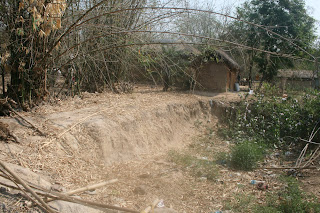"A watermark is a recognizable image or pattern in paper that appears as various shades of lightness/darkness when viewed by transmitted light (or when viewed by reflected light, atop a dark background), caused by thickness or density variations in the paper.Watermarks are often used as security features of banknotes, passports, postage stamps, and other documents to prevent counterfeiting."
Through writing and design exercises on the deckel of the paper making structure the water Mark technique will be practised to explore different signs and symbols that are existing in the minds of the Santal society in these villages.
Some A3 sized deckel were given to the families who participated in the initial bamboo leaf paper making workshop.The ladies from the families made some designs from their memory on the netted part of the deckel.Then papers were made with them.Documents of first few exercises of Water Mark on paper made from bamboo leaf.
From Wikipedia, the free encyclopedia
In this present project of making paper from Bamboo leaf together with the santali people of Santiniketan,water mark will not be used for prevention of counterfeiting, it will be practiced to document the cultural memory and knowledge of different generation of santali community living around Santiniketan.Santniketan have considerably affected the life of the santali community in villages like,Fuldanga, Pearson Palli, Bagan Para,Balipara and so on in multiple ways.Many of the Santals are now working as permanent employee of Visva Bharati University.More over many of the santali young boys and girla are now getting higher education the university and naturally the social life in these villages are more urbanised. As Baidyanath would put it educated santals today feels alienated from the Santali village life and are starting to make efforts to participate in the mainstream Santali life.Through writing and design exercises on the deckel of the paper making structure the water Mark technique will be practised to explore different signs and symbols that are existing in the minds of the Santal society in these villages.
Some A3 sized deckel were given to the families who participated in the initial bamboo leaf paper making workshop.The ladies from the families made some designs from their memory on the netted part of the deckel.Then papers were made with them.Documents of first few exercises of Water Mark on paper made from bamboo leaf.























































